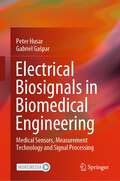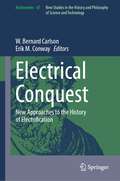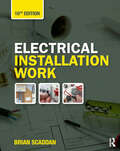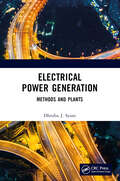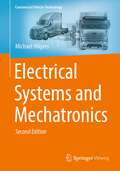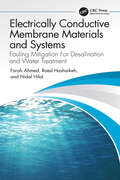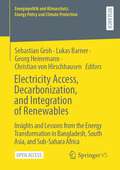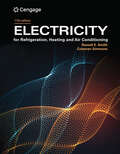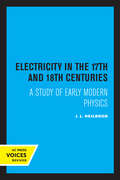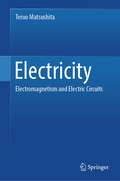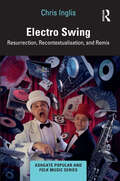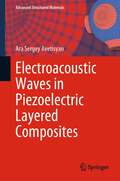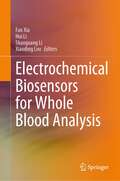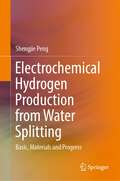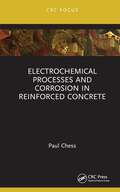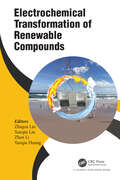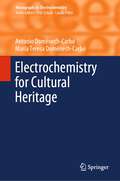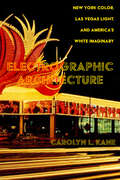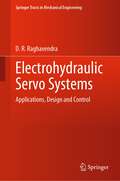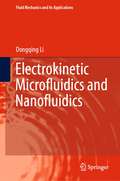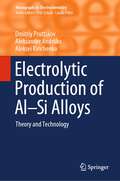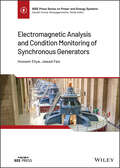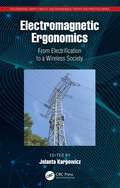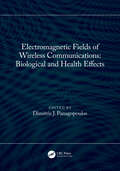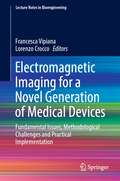- Table View
- List View
Electrical Biosignals in Biomedical Engineering: Medical Sensors, Measurement Technology and Signal Processing
by Peter Husar Gabriel GašparDas grundlegende Kompendium führt in das zunehmend wichtiger werdende Thema der Biosginalverarbeitung ein. Der inhaltliche Aufbau orientiert sich an der Abfolge der diagnostischen Kette: von Sensorik, Signalverstärkung und -konditionierung über Signalabtastung und -digitalisierung, Methoden der Biosignalverarbeitung bis zu Auswertung und Diagnosevorschlag. Dabei liefert jedes Kapitel das entsprechende theoretische und methodische Wissen, behandelt Realisierungsalternativen und stellt Praxisbeispiele sowie die aktuell verfügbare Technik vor.
Electrical Conquest: New Approaches to the History of Electrification (Archimedes #67)
by W. Bernard Carlson Erik M. ConwayThis book, drawing on fresh scholarship, investigates electrification in new places and across different time periods. While much of our understanding of electrification as a historical process is based on the seminal work done by Thomas P. Hughes in Networks of Power (1983), the scholars in this volume expand and revise Hughes’ systems approach to suggest that electrification is a heterogeneous and contingent process. Moreover, the contributors suggest that the conquest of the world by electricity remains incomplete despite more than a century elapsing. Above all, though, this book provides context for thinking about what lies ahead as humans continue their conquest of the earth through electricity. As we become increasingly dependent on electricity to power our lights, heat and cool our homes, turn the wheels of industry, and keep our information systems humming, so we are ever more vulnerable when the grid runs into trouble.Chapter "Surveying the Landscape: The Oil Industry and Alternative Energy in the 1970s" is available open access under a Creative Commons Attribution 4.0 International License via link.springer.com.
Electrical Installation Work
by Brian ScaddanThis highly successful book is now updated in line with the Amendment 2-2022 of 18th Edition of the Wiring Regulations. It provides a topic-by-topic progression through the areas of electrical installations, including how and why electrical installations are designed, installed and tested. This tenth edition contains new material on batteries, LED and ELV lighting, data cabling and renewable electricity generation and distribution, with some focus on medical locations, and a glossary of terms. The guidance on tools used and safety legislation has also been brought up to date. Brian Scaddan’s subject-led approach makes this a valuable resource for professionals and students on both City & Guilds and EAL courses. This approach also makes it easy for those who are learning the topic from scratch to get to grips with it independently of any particular course. The book is widely used in education and training across the UK and has been published for almost 40 years.
Electrical Power Generation: Methods and Plants
by Dhruba J. SyamIn today’s world, per capita consumption of electricity in a country is considered as one of the important indices of its developmental status: both economic and technological. Engineering students as well as the professional beginners, studying and working in the field of Electrical Power Generation and Power Plant Administration, should get a reasonable level of familiarization with the concepts of various technological methods and plants in order to acquire necessary knowledge and competency for a worthwhile professional career in the subject field. This book attempts to provide relevant knowledge inputs by way of providing conceptual clarity on various aspects of the subject. It will be helpful for students of Electrical and Mechanical Engineering. Print edition not for sale in South Asia (India, Sri Lanka, Nepal, Bangladesh, Pakistan and Bhutan)
Electrical Systems and Mechatronics (Commercial Vehicle Technology)
by Michael HilgersThe aim of this work, consisting of 9 individual, self-contained booklets, is to describe commercial vehicle technology in a way that is clear, concise and illustrative. Compact and easy to understand, it provides an overview of the technology that goes into modern commercial vehicles.Starting from the customer's fundamental requirements, the characteristics and systems that define the design of the vehicles are presented knowledgeably in a series of articles, each of which can be read and studied on their own. This volume, Electrical Systems and Mechatronics, offers an introduction to the mechatronics in a commercial vehicle. The electrical and electronic systems are presented, up to and including the advanced driver assistance systems. The compressed air system and the commercial vehicle brake are explained to give the reader a comprehensive overview, such as is helpful for understanding in training and in practice.
Electrically Conductive Membrane Materials and Systems: Fouling Mitigation For Desalination and Water Treatment
by Nidal Hilal Farah Ahmed Raed HashaikehElectrically Conductive Membrane Materials and Systems offers in-depth insight into the transformative role of electrically conductive materials in membrane separation processes for desalination and water treatment. The book focuses on the intelligent design of conductive membranes and systems, fouling and related phenomena, fouling control using electrically conductive materials, and electrically tunable membrane systems for microfiltration, ultrafiltration, nanofiltration, reverse osmosis, and membrane distillation. With rising concerns around inaccessibility to freshwater and the ever increasing threats of population growth, climate change, and urban development, the book brings electrically conducting materials to the forefront of membrane separation technology with an emphasis on their role in the mitigation of fouling and related phenomena. Electrically conducting materials expand the versatility of membrane technology and ultimately improve access to safe water. The book is important reading for scientists, engineers, entrepreneurs, and enthusiasts from the water industry who seek to familiarize themselves with a groundbreaking area of study within modern desalination and water treatment. • Explores novel membrane materials and systems from preparation methods, materials selection, and their application in monitoring, fouling control, and performance enhancement. • Examines the mechanism of fouling prevention and cleaning in various electrically conductive materials. • Evaluates the scalability of antifouling materials and coatings, as well as electrically enhanced processes for monitoring and control in membrane separation technology. • Assesses advantages and limitations of applying electrically conductive membrane systems to fouling control for specific water treatment applications. • Provides a critical review of scientific literature in the specialized area of electrical conductive materials and systems for membrane technology.
Electricity Access, Decarbonization, and Integration of Renewables: Insights and Lessons from the Energy Transformation in Bangladesh, South Asia, and Sub-Sahara Africa (Energiepolitik und Klimaschutz. Energy Policy and Climate Protection)
by Sebastian Groh Christian Von Hirschhausen Lukas Barner Georg HeinemannThis Open-Access-Book covers different aspects of the low-carbon energy transformation in a unique manner, with a particular focus on two regions, South Asia and Sub-Saharan Africa. The first part of the book provides useful insights on changes and reforms in the energy sector of Bangladesh, while the second part illustrates the low-carbon energy transformation in South Asia and the third part covers lessons from Sub-Saharan Africa. In all of these regions, the energy sector is undergoing major changes, driven by the four D’s: Decarbonization, decentralization, digitization, and democratization. Major overhauls are taking place at all levels: The country level, where energy mixes are rapidly changing, the corporate level, where large state-owned and private companies are challenged and new actors are emerging, and the local level, where technical and regulatory change has made citizen engagement and community power an option to replace or at least complement centralized supply structures.
Electricity for Refrigeration, Heating and Air Conditioning
by Russell E. Smith Coleman SimmonsAcclaimed for its meticulous accuracy and easy-to-understand presentation, this trusted text helps readers master the electrical principles and practices they need to succeed as professional installation and service technicians. ELECTRICITY FOR REFRIGERATION, HEATING AND AIR CONDITIONING, Eleventh Edition, combines a strong foundation in essential electrical theory with a highly practical focus on real-world tasks and techniques, presenting concepts, procedures and success tips in a logical and effective way. Thoroughly updated for today’s professionals, the Eleventh Edition features up-to-date information based on current trends, technology and industry practices--including key diagnosis and troubleshooting methods--making this valuable resource ideal for both students new to the field and current practitioners seeking to update their knowledge and skills. Available with this text is The Complete HVAC Lab Manual, which features over 250 lab exercises covering 15 topic areas. See the supplements section for more details.
Electricity in the 17th and 18th Centuries: A Study of Early Modern Physics
by J. L. HeilbronThis title is part of UC Press's Voices Revived program, which commemorates University of California Press’s mission to seek out and cultivate the brightest minds and give them voice, reach, and impact. Drawing on a backlist dating to 1893, Voices Revived makes high-quality, peer-reviewed scholarship accessible once again using print-on-demand technology. This title was originally published in 1979.
Electricity: Electromagnetism and Electric Circuits
by Teruo MatsushitaThis book leads students to learn electromagnetism and then moves to chapters about electric circuits. It aims to give an understanding of electromagnetism which gives a fast way to master the features of circuit elements such as resistors, capacitors, and coils that compose electric circuits. The author provides chapters on electromagnetism and electric circuits separately and gives a chapter explaining the correlation between them in detail.In the chapters for electric circuit, DC electric circuits, transient and steady response of AC electric circuits are treated. AC circuit theory is introduced for describing the phenomena in circuits. Theoretical treatments such as branch current method, closed current method, and node potential method are also introduced to show the validity of solution methods that have been used in the book. The book can serve as a compact textbook for lectures, as an introduction for hardware system and electric control systems, and mechanical systems. Chapters for electromagnetism or ones for electric circuits are suitable for a lecture over a semester.
Electro Swing: Resurrection, Recontextualisation, and Remix (Ashgate Popular and Folk Music Series)
by Chris InglisElectro swing is a relatively recent musical style and scene which combines the music of the swing era with that of the age of electronic dance music. Chris Inglis considers key questions about electro swing’s place in contemporary society, including what it may mean for a contemporary genre to be so reliant upon the influences of the past; the different ways in which jazz may be presented to a modern audience; how one may go about defining jazz in todays postmodern world; and how this emergent genre may be analysed in terms of the wider issues of race and class consumption.
Electroacoustic Waves in Piezoelectric Layered Composites (Advanced Structured Materials #182)
by Ara Sergey AvetisyanThis book deals concisely and coherently with various issues related to electroacoustic waves in piezoelectric layered composites.Starting with the basic linear equations and relations of electromagnet elasticity of homogeneous anisotropic piezoelectric media, the book considers the conditions for possible field or partial conjugation of physical and mechanical fields at the junction of two homogeneous media with geometrically homogeneous surfaces. The variety of electromechanical boundary conditions and the separation of plane and anti-plane fields of elastic deformation in homogeneous piezoelectric crystals are discussed.Then, the statements of the electroacoustic problem in piezo textures are studied and a layered piecewise-homogeneous piezoelectric waveguide is introduced, with non-acoustic contact between different piezoelectric layers.Non-acoustic contact between different piezoelectric layers can lead to the propagation of a hybrid of electroactive waves of plane and anti-plane elastic deformations.In the last part of the book, the problem of controlling electroacoustic waves in a waveguide is formulated. A method for solving problems of control of electroacoustic waves by non-contact surface action is proposed.
Electrochemical Biosensors for Whole Blood Analysis
by Shaoguang Li Hui Li Fan Xia Xiaoding LouThis book illustrates recent advances in developing sensitive and selective electrochemical biosensors for their whole blood application. Known to be a cutting-edge and fast-growing technology, electrochemical biosensors demonstrate their potential in laboratories, industries, and healthcare to achieve specific and direct target detection in complex media, and have become an emerging technology for guiding personalized medicine. The book first demonstrates methods and models to cover the detection of a variety of target molecules in whole blood, including ions, small molecules, nucleic acids, proteins, cells, etc. Then, it provides comments on various detection strategies employed to improve sensors' sensitivity, specificity, selectivity, and reproducibility as well as presenting the laws and principles. In addition, it summarizes achievements and challenges from recent years. Finally, it provides future perspectives and opportunities in electrochemical biosensors including point of care detection, molecular diagnostics and the integration of this sensor platform with multidisciplinary technologies, towards the ultimate goal of personalized medicine. The book integrates abundant viewpoints from multiple sciences and is helpful and valuable to a wide readership in the various fields of biochemistry, biophysics, bioengineering, and pharmaceutics.
Electrochemical Hydrogen Production from Water Splitting: Basic, Materials and Progress
by Shengjie PengThis book provides a systematic and comprehensive introduction to the fundamentals of hydrogen energy, hydrogen energy-related technologies and systems, and the environmental and economic impacts of hydrogen energy. This book is rich in content, combining theory with practice and reflecting the latest world achievements in hydrogen energy utilization and research. It is used by a wide range of scientific and technologists engaged in the development and utilization of hydrogen energy and other energy sources. It is also referenced for technical workers in power engineering, aerospace, chemistry, chemical engineering, refrigeration, metallurgy, and those engaged in safety management, as well as for teachers and students of related disciplines in higher education institutions. Furthermore, this book makes some modest contribution to the development of hydrogen energy by strengthening the hydrogen energy research teams.
Electrochemical Processes and Corrosion in Reinforced Concrete
by Paul ChessSome reinforced concrete structures prematurely corrode as they age, with significant financial implications, but it is not immediately clear why some are more durable than others. This book looks at the various mechanisms for corrosion and how what seemed to be a relatively simple matter has become more complex the further it is understood due to the properties of concrete, steel and the way reinforced concrete structures are constructed. The significance of electrochemical processes is identified with recent research using new technology discussed. Specialist contractors, consultants and owners of corrosion damaged structures will find this an extremely useful resource. It will also be a valuable reference for students at postgraduate level.
Electrochemical Transformation of Renewable Compounds
by Zhiqun Lin Zhen Li Xueqin Liu Yanqiu HuangElectrochemical conversion process can be used to generate power, store energy and synthesize chemicals, which plays a key role in the development of sustainable energy resources. Electrochemical Transformation of Renewable Compounds presents the basic fundamentals of different electrochemical transformations for clean energy and places significant emphasis on the key developments of various electrochemical processes using state-of-the-art materials. Written by electrochemical energy scientists who have worked on the application of electrocatalysis in the environmental and energy area, this book provides comprehensive coverage of main electrochemical transformation processes, including oxygen evolution, hydrogen generation, oxygen reduction, carbon dioxide reduction, nitrogen reduction, methanol oxidation, urea oxidation and ammonia oxidation.
Electrochemistry for Cultural Heritage (Monographs in Electrochemistry)
by Antonio Doménech-Carbó María Teresa Doménech-CarbóThis monograph overviews the importance of electrochemistry in the field of cultural heritage, including archaeology, conservation and restoration topics. The application of electrochemical techniques in these domains have experienced a notable growth during the last ten years, in particular with regards to the elucidation of composition, manufacturing techniques and chronology of archaeological artefacts. This book describes the application of solid state electrochemistry techniques for the use of samples at the nanogram level from paintings, metallic, ceramic, glass, glazed, wooden, and other objects, and it also includes the description of new dating procedures for archaeological objects made of these materials. It is a valuable contribution to the field of cultural heritage and will be of great interest to archaeologists, conservators and restorers as well as to physicists and chemists working on the scientific examination of works of art.
Electrographic Architecture: New York Color, Las Vegas Light, and America's White Imaginary
by Prof. Carolyn L. KaneBridging histories of technology, media studies, and aesthetics, Electrographic Architecture forges a critical narrative of the ways in which illuminated light and color have played key roles in the formation of America's white imaginary. Carolyn L. Kane charts the rise of the country's urban advertisements, light empires, and neoclassical buildings in the early twentieth century; the midcentury construction of polychromatic electrographic spectacles; and their eclipse by informatically intense, invisible algorithms at the dawn of the new millennium. Drawing on archival research, interviews, and visual analysis, Electrographic Architecture shows how the development of America's electrographic surround runs parallel to a new paradigm of power, property, and possession.
Electrohydraulic Servo Systems: Applications, Design and Control (Springer Tracts in Mechanical Engineering)
by D. R. RaghavendraThis book covers the fundamental concepts of electrohydraulic (EH) servo systems in detail and also presents the developments about power, quadratic response, and control flexibility of EH servo systems with applications in aircraft/aerospace engineering, mobile equipment, material/structure testing, motion simulators, and strategic defense sectors. Various topics covered in this books are systems and configurations of servo systems, components, applications, design of SISO and MIMO and control options of SISO and MIMO systems. It further includes a chapter on contamination control, fault detection and diagnosis (FDD) of these systems. The detailed working procedures and advice on implementation routines presented in this book will help readers to apply the control models and systems presented so as to make their own servo systems more efficient. The book will be useful for mechanical engineers and professionals involved in the analysis and design of electrohydraulic control systems, especially in advanced hydraulic industries, the aeronautical and space, and automotive industries. It would also be a useful reference for advanced courses in EH systems.
Electrokinetic Microfluidics and Nanofluidics (Fluid Mechanics and Its Applications #133)
by Dongqing LiThis book reviews the latest advancement of microfluidics and nanofluidics with a focus on electrokinetic phenomena in microfluidics and nanofluidics. It provides fundamental understanding of several new interfacial electrokinetic phenomena in microfluidics and nanofluidics. Chapter 1 gives a brief review of the fundamentals of interfacial electrokinetics. Chapter 2 shows induced charge electrokinetic transport phenomena. Chapter 3 presents the new advancement in DC dielectrophoresis. Chapter 4 introduces a novel nanofabrication method and the systematic studies of electrokinetic nanofluidics. Chapter 5 presents electrokinetic phenomena associated with Janus particles and Janus droplets. Chapter 6 introduces a new direction of electrokinetic nanofluidics: nanofluidic iontronics. Chapter 7 discusses an important differential resistive pulse sensor in microfluidics and nanofluidics.
Electrolytic Production of Al–Si Alloys: Theory and Technology (Monographs in Electrochemistry)
by Dmitriy Pruttskov Aleksander Andriiko Aleksei KirichenkoThis monograph presents the theoretical background of the industrial process for the production of Al-Si alloys in standard aluminum electrolyzers. It reviews the physical chemistry and electrochemistry of cryolite melts containing silica and focuses on analyzing the exchange reactions in Na3AlF6–Al2O3–SiO2 melts. It presents the kinetics and mechanism of Si(IV) electroreduction in Na3AlF6–Al2O3–SiO2 melts on Al cathodes while the current yields as well as industrial tests performed are discussed. The modern research trends in the field are also overviewed. Providing readers with information not easily obtained in any other single source, this book is of great interest to researchers, graduates, and professionals working in the fields of electrochemistry and technology of cryolite-based melts.
Electromagnetic Analysis and Condition Monitoring of Synchronous Generators (IEEE Press Series on Power and Energy Systems)
by Jawad Faiz Hossein EhyaElectromagnetic Analysis and Condition Monitoring of Synchronous Generators Discover an insightful and complete overview of electromagnetic analysis and fault diagnosis in large synchronous generators In Electromagnetic Analysis and Condition Monitoring of Synchronous Generators, a team of distinguished engineers delivers a comprehensive review of the electromagnetic analysis and fault diagnosis of synchronous generators. Beginning with an introduction to several types of synchronous machine structures, the authors move on to the most common faults found in synchronous generators and their impacts on performance. The book includes coverage of different modeling tools, including the finite element method, winding function, and magnetic equivalent circuit, as well as various types of health monitoring systems focusing on the magnetic field, voltage, current, shaft flux, and vibration. Finally, Electromagnetic Analysis and Condition Monitoring of Synchronous Generators covers signal processing tools that can help identify hidden patterns caused by faults and machine learning tools enabling automated condition monitoring. The book also includes: A thorough introduction to condition monitoring in electric machines and its importance to synchronous generators Comprehensive explorations of the classification of synchronous generators, including armature arrangement, machine construction, and applications Practical discussions of different types of electrical and mechanical faults in synchronous generators, including short circuit faults, eccentricity faults, misalignment, core-related faults, and broken damper bar faults In-depth examinations of the modeling of healthy and faulty synchronous generators, including analytical and numerical methods Perfect for engineers working in electrical machine analysis, maintenance, and fault detection, Electromagnetic Analysis and Condition Monitoring of Synchronous Generators is also an indispensable resource for professors and students in electrical power engineering.
Electromagnetic Ergonomics: From Electrification to a Wireless Society (Occupational Safety, Health, and Ergonomics)
by Jolanta KarpowiczErgonomics is the branch of engineering science in which biological science is used to study the relationship between workers and their environments. Because of the use of electricity for many purposes, one environmental factor that has become omnipresent today is the electromagnetic field, also referred to as electromagnetic radiation or a fraction of the non-ionizing radiation. The complex interactions of electromagnetic energy with material objects contribute to ergonomics issues because they can cause health hazards in workers, trigger accidental situations, limit the ability of workers to work safely and disturb the function of electronic devices, including medical implants, etc. A better understanding of complex electromagnetic issues in the work environment is considered in this book. This title will be beneficial to workers affected by electromagnetic hazards including wireless transfer of information or power, wireless (induction) heating, joining metal elements with electric-supplied techniques, capacitive heating of dielectric materials, physiotherapeutic or cosmetic electromagnetic treatments, antitheft gates and other monitoring or control systems using wireless solutions, electric transportation and many more. It will help prevent common misunderstandings about electromagnetic hazards and sufficiently reduce where they appear. Electromagnetic Ergonomics is designed to have a positive influence on public health and worker safety in the work environment and brings broad benefits, in particular with respect to research planning and the interpretation of the results, as well as the implementation of science-based evidence regarding the evaluation and elimination of EMF hazards in the operations of enterprises and environmental, labor and sanitary inspections, as well as government regulators responsible for environmental safety issues in the workplace and the daily life environment.
Electromagnetic Fields of Wireless Communications: Biological and Health Effects
by Dimitris J. PanagopoulosThis book reflects contributions from experts in biological and health effects of Radio Frequency (RF)/Microwave and Extremely Low Frequency (ELF) Electromagnetic Fields (EMFs) used in wireless communications (WC) and other technological applications. Diverse topics related to physics, biology, pathology, epidemiology, and plausible biophysical and biochemical mechanisms of WC EMFs emitted by antennas and devices are included. Discussions on the possible consequences of fifth generation (5G) mobile telephony (MT) EMFs based on available data and correlation between anthropogenic EMF exposures and various pathological conditions such as infertility, cancer, electro-hypersensitivity, organic and viral diseases, and effects on animals, plants, trees, and environment are included. It further illustrates individual and public health protection and the setting of biologically- and epidemiologically-based exposure limits. Features: Covers biological and health effects, including oxidative stress, DNA damage, reproductive effects of mobile phones/antennas (2G, 3G, 4G), cordless phones, Wi-Fi, etc. Describes effects induced by real-life exposures by commercially available devices/antennas. Illustrates biophysical and biochemical mechanisms that fill the gap between recorded experimental and epidemiological findings and their explanations. Explores experimental and epidemiological facts and mechanisms of action. Provides explanations and protection tips. Transcends across physical, biological, chemical, health, epidemiological, and environmental aspects of the topic. This book is aimed at senior undergraduate/graduate students in physics, biology, medicine, bioelectromagnetics, electromagnetic biology, non-ionizing radiation biophysics, telecommunications, electromagnetism, bioengineering, and dosimetry.
Electromagnetic Imaging for a Novel Generation of Medical Devices: Fundamental Issues, Methodological Challenges and Practical Implementation (Lecture Notes in Bioengineering)
by Lorenzo Crocco Francesca VipianaThis book offers the first comprehensive coverage of microwave medical imaging, with a special focus on the development of novel devices and methods for different applications in both the diagnosis and treatment of various diseases. Upon introducing the fundamentals of electromagnetic imaging, it guides the readers to their use in practice by providing extensive information on the corresponding measurement and testing techniques. In turn, it discusses current challenges in data processing and analysis, presenting effective, novel solutions, developed by different research groups. It also describes state-of-the-art medical devices, which were designed for specific applications, such as brain stroke monitoring, lymph node diagnosis, image-guided hyperthermia, and chemotherapy response monitoring. The chapters, which report on the results of the EU-funded project EMERALD (ElectroMagnetic imaging for a novel genERation of medicAL Devices) are written by leading European engineering groups in electromagnetic medical imaging, whose coordinated action is expected to accelerate the translation of this technology “from research bench to patient bedside”. All in all, this book offers an authoritative guide to microwave imaging, with a special focus on medical imaging, for electrical and biomedical engineers, and applied physicists and mathematicians. It is also intended to inform medical doctors and imaging technicians on the state-of-the-art in non-invasive imaging technologies, at the purpose of inspiring and fostering the translation of research into clinical prototypes, by promoting a stronger collaboration between academic institutions, industrial partners, hospitals, and university medical centers.
